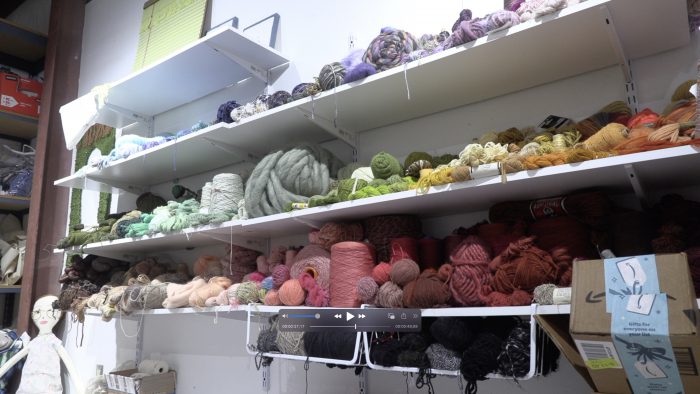Ary Bird was excited to showcase the dozens of hours of work she has put in over the past few months in the fibers department. Her studio draws you in with a vibrant wall of yarn of various colors that has grown over the past decade. She has not one, not two, but three looms in her 10-foot by 10-foot space.
Bird is a graduate student and associate instructor and has been working with fabrics and fibers for most of her life. This is the first time her department has been featured in Open Studios. She hung up her projects on the wall and explained the meanings behind them. One piece was a poem about which she stitched onto sheer fabric.
I had the pleasure of being the first person to see one of her most recent works. She said she had been hiding it from the rest of her cohort until she could debut it at the event. It was a patch of fabric that had been double woven with red beads sewn on.
You can see fascinating creations such as a beetle with Donald Trump’s head attached and a giant depiction of Mitch McConnell as a Kentucky-native scorpion. The artist who created them said he is working on a project to make one bug politician every week.
The studios varied drastically in theme and medium. One artist displayed a rubber severed horse leg and another a giant cardboard juice box. The juice box artist also had real juice boxes available for spectators.
Student sculptures were also part of Open Studios. Sculpture, Figure Sculpture, and Ceramics were among the classes that presented artwork.
The Interior Design Program was also featured. In Kirkwood Hall, students had rooms set up with different activities involving interior design. One room was designated for making mood boards, one hosted a trivia game, and another had a wheelchair course set up.
The course is to help able bodied people understand the kinds of issues that people who use wheelchairs experience daily. Simple acts like reaching for a marker or writing on a board are surprisingly much more difficult when you are bound to a wheelchair. Interior designers, like Liz Torres, must take everybody into account when designing buildings.
One idea Torres had to increase inclusivity is instead of providing stairs and a ramp, build just a ramp. Everyone has the ability to use a ramp.

